The HP OmniBook 5 14in is an all-day ultraportable for £799 – but it's flanked by a queue of capable challengers
An affordable Snapdragon X laptop with lots to recommend it, but the price puts it up against tough competition
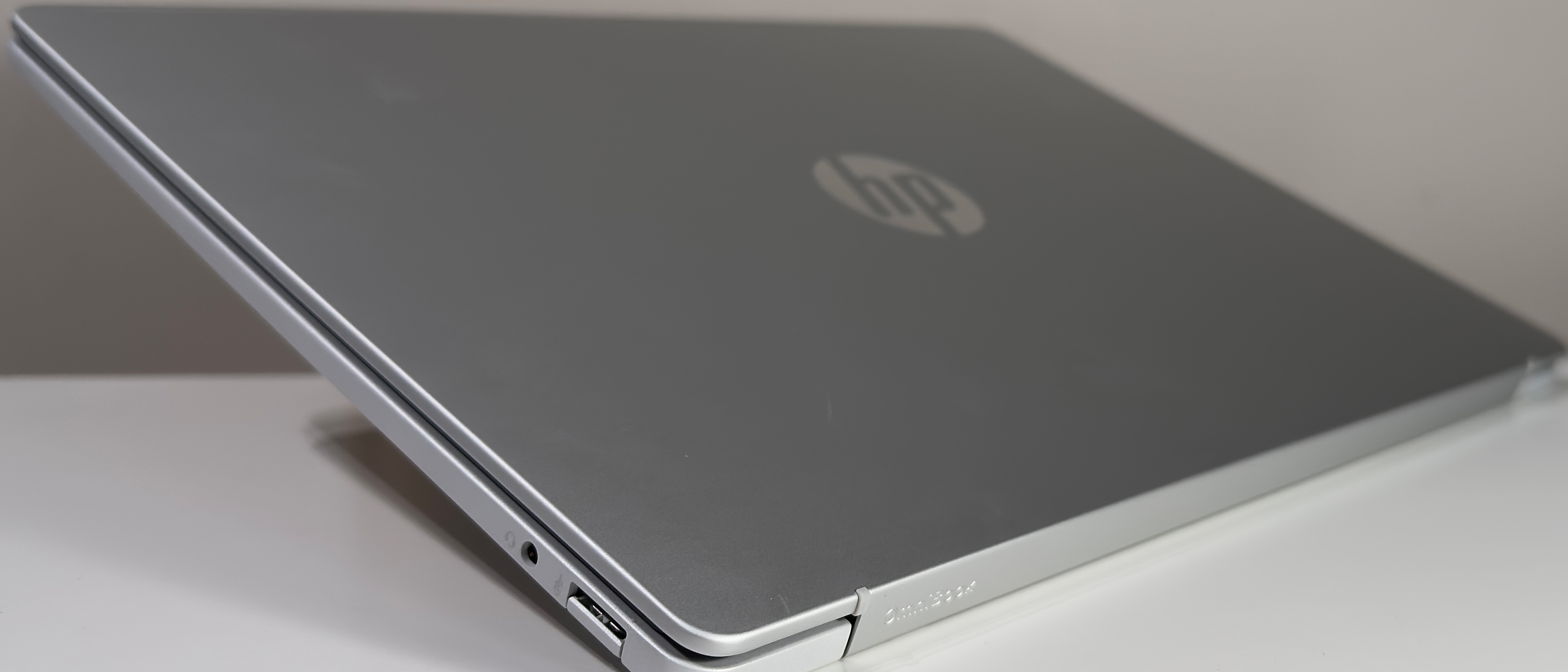
-
+
Stylish and practical
-
+
All-day battery life
-
+
Lovely 2K OLED display
-
-
GPU performance is poor
-
-
Mediocre webcam

For £799, the HP OmniBook 5 14in attempts a tricky balancing act. With that relatively limited budget, it seeks to be fast enough to rival Intel and AMD alternatives; light, robust, and long-lasting enough to earn its ultraportable stripes, and stylish enough to distract buyers from similarly priced rivals. It's fair to say that HP is setting a high bar for success.
On the first point, it's the first laptop we've seen with Qualcomm's pared-back Snapdragon X processor. These were announced back in CES 2025, and the expectation is solid Windows on ARM performance backed up by all-day battery life.
On the other points, HP knows the drill: its recent laptop designs consistently fuse style, sensible design, and sturdy build. The OmniBook 5 14in is no exception, but the burning question is whether Qualcomm can deliver on its side of the bargain.
HP OmniBook 5 14in: Design & connectivity
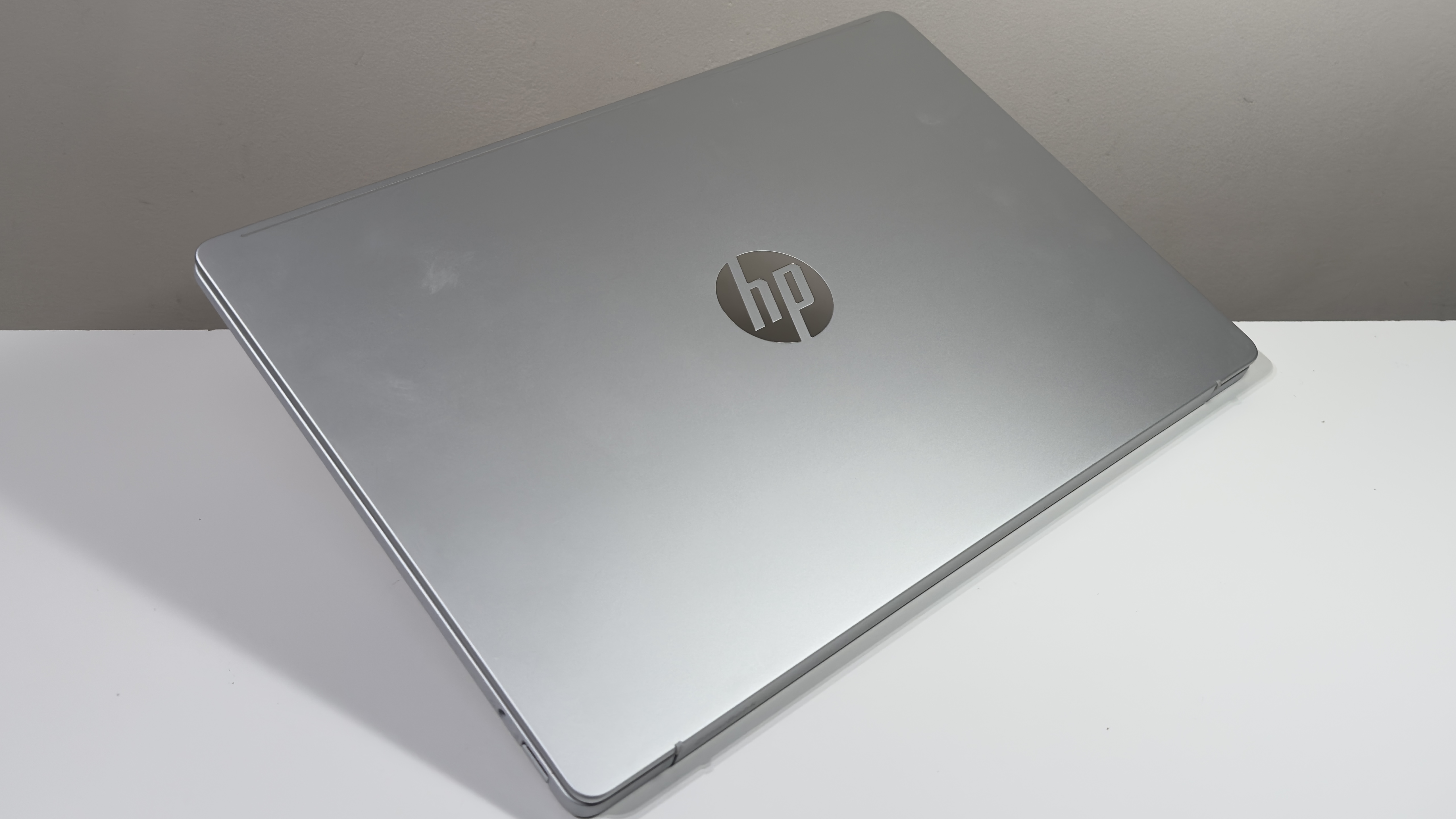
It gets off to a solid start. The design isn't particularly exciting in any way, but the sandblasted matte silver metal frame feels solid from top to toe, and the 1.3kg weight and dainty 13mm thickness make for a portable little package. There is a little flex in the base and lid, but nothing we'd worry about.
Connectivity is minimal but ample. There are two 10Gbps USB-C ports on the left-hand flank, and a drop-jaw 10Gbps USB-A port on the right, alongside a 3.5mm headset connection. You also get Wi-Fi 6E and Bluetooth 5.3 connectivity.
There's a 1080P webcam, too, replete with a privacy shutter. The image quality is very middle of the road, however. There's no fine detail to speak of, and colors tend to look oversaturated. In our testing, skintones often looked excessively flushed and reddish.
You also get a stereo set of speakers that fire downwards from under the front edge. These go rather loud, but it's a rough and ready noise – there's no delicacy or body to really make music pleasant to listen to.
Sign up today and you will receive a free copy of our Future Focus 2025 report - the leading guidance on AI, cybersecurity and other IT challenges as per 700+ senior executives
HP OmniBook 5 14in: Keyboard and touchpad
HP has produced some of my favourite keyboards in recent times, and the OmniBook 5 is no exception. The chiclet keys feel good, with a light, snappy feedback, and the chiclet design makes for a keyboard that feels really spacious and roomy.
The layout is eminently sensible, too. You get nice, wide shift keys, and the only mild disappointment is that you don't get a full height enter key. The up and down cursor keys are also crushed into a single height row, but that's hardly a unique compromise in 2025.
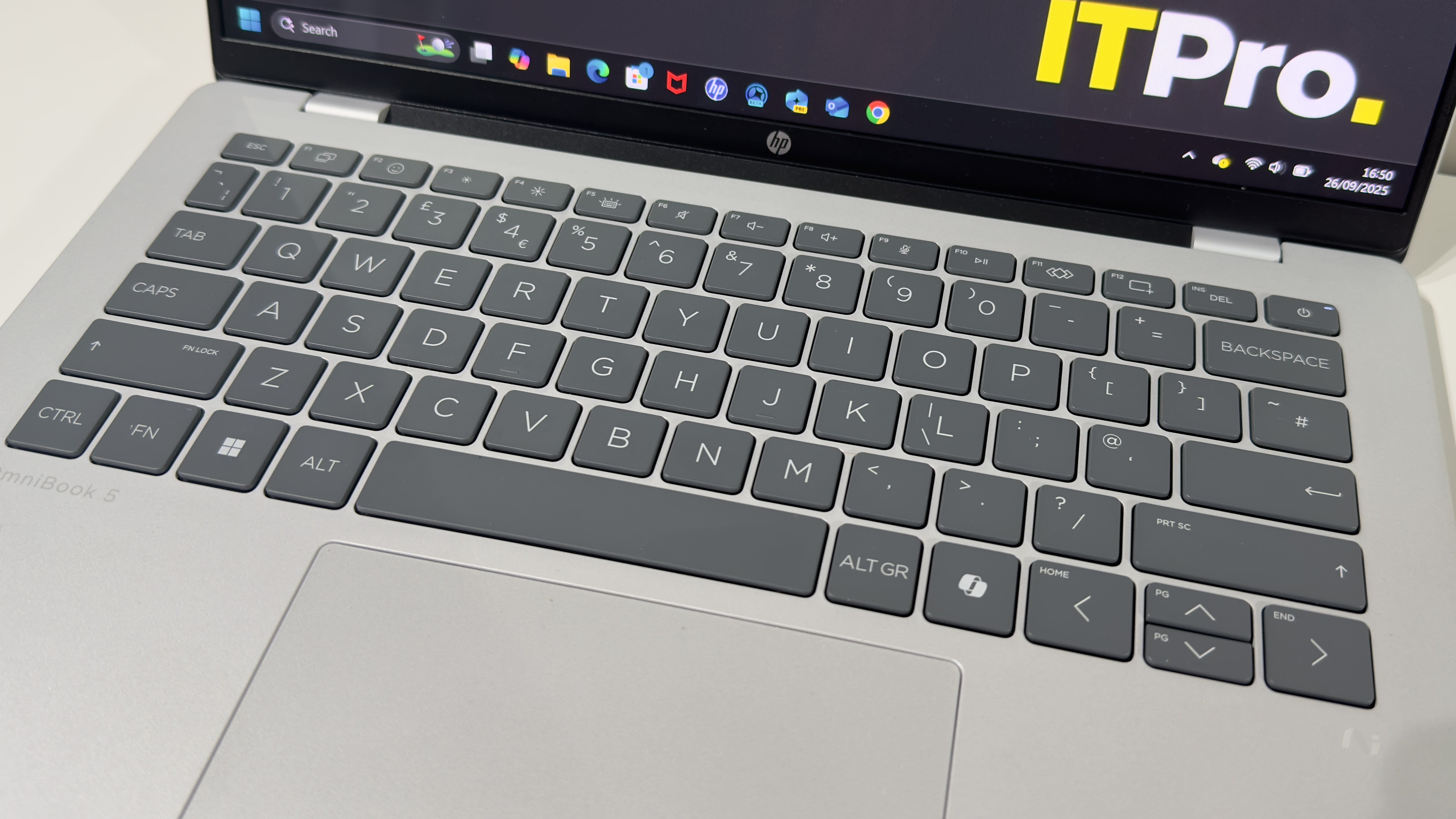
The touchpad is a standard mechanical type, and it's good. Multifingered gestures all work reliably, and there are no usability issues which we encountered in our testing. In fact, the only slight oddity is that the touchpad rattles slightly with the tiniest amount of pressure. This may possibly be intentional, though, as it means that you get an audible and physical bit of feedback with even the lightest taps. It's not a big issue in any case.
HP OmniBook 5 14in: Display
The OLED display is lovely. The 1,920 x 1,200 resolution delivers a claimed 300cd/m2 peak brightness, 95% DCI-P3 coverage, and a near-instantaneous 0.2ms response time. Subjectively, we can't find fault with it. Colors are wonderfully vivid and saturated, and while text looks noticeably softer than on LCD panels, it's still pleasant to use for all-day working.
It's worth noting that OLED screens don't get as bright as LCD-based alternatives, but this is only likely to cause issues if you're using it outside on really sunny days – during our testing, it was more than bright enough for indoor usage at around 80% brightness, even with large Velux sunlights directly above.
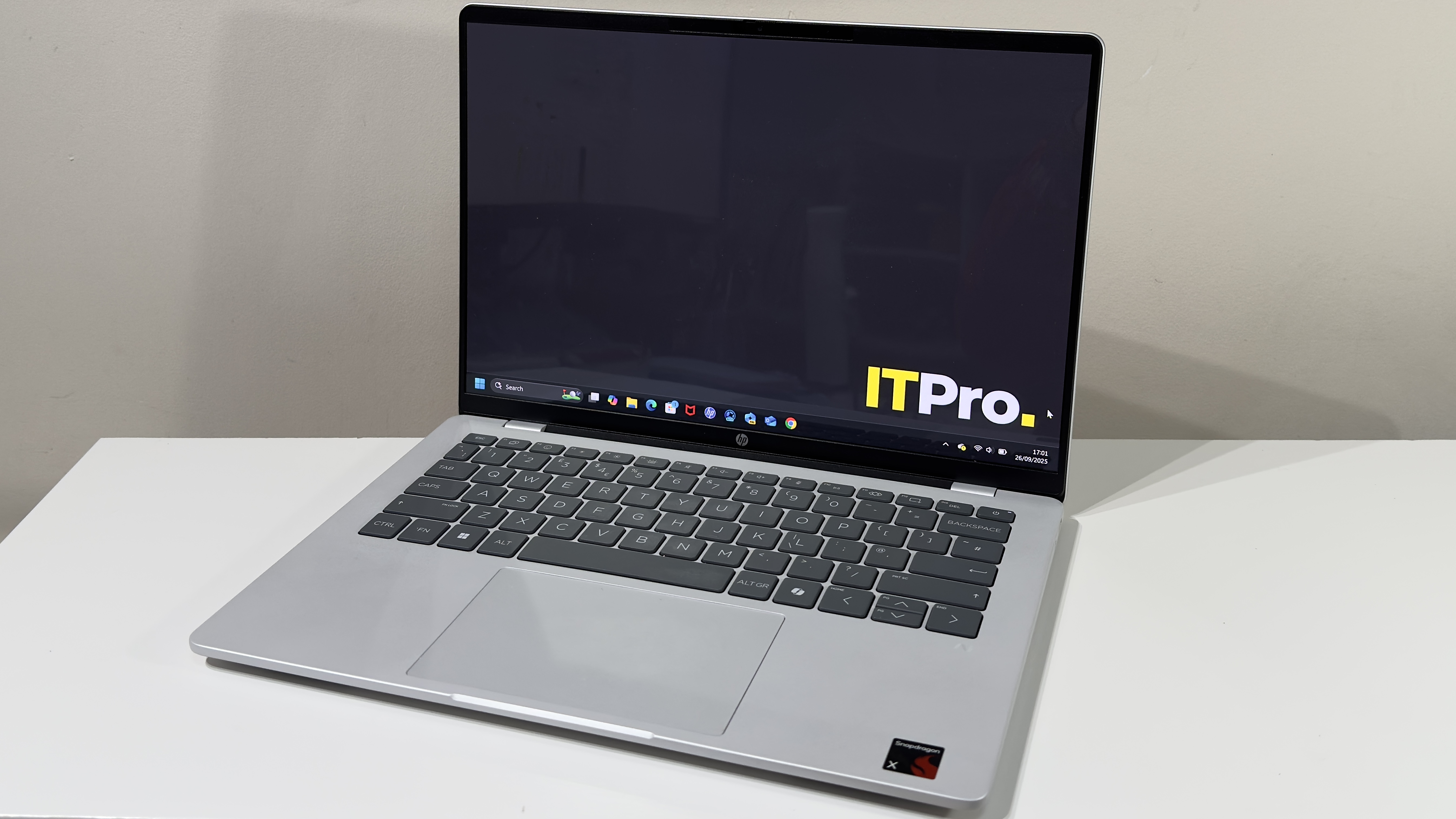
In our various image tests, the OmniBook's panel put in a really good performance. Color accuracy is right on the money, with an average Delta E of 1.63 and a white point of 6,356k, which is almost dead on the ideal of 6,500k. Peak brightness measured at 299cd/m2, which matches HP's claims. And when it comes to color coverage, we actually measured the panel as providing 99% of DCI-P3, which exceeds HP's claims by quite a bit.
HP OmniBook 5 14in: Performance
HP has employed the newest entry-level addition to the Snapdragon family, the 8-core X1-26-100. Clockspeeds top out at 2.96GHz, and there's still a healthy 45 TOPS of AI-crunching power thanks to the Hexagon NPU. The biggest downgrade is the GPU: the Adreno X1-45 is dramatically less powerful than the best in the family.
First, the good news. Battery life is stupendous. The Snapdragon chip and a relatively large 65Wh battery mean that the OmniBook 5 lasted 20hrs 40mins in our battery rundown test. And in day-to-day usage, that all-day battery life figure translates into nearly two working days with Wi-Fi enabled and working mostly in the Chrome browser.
Application performance is pretty good overall, too. Compared to the top-end Snapdragon X Elite chip in the Dell XPS 13 9345, the HP was between 25% and 30% behind in Geekbench 6's single – and multi-threaded tests, and around 20% behind in Cinebench 2024's single – and multi-threaded tests.
Raise the stakes with Intel's mid-range Lunar Lake and AMD's Strix Point processors, and the X1-26-100 remains quietly impressive. Single-core performance is only around 20% slower than those rivals, which you'd normally find on markedly pricier laptops, and multi-core performance in Cinebench 2024 is only around 20% behind the 8-core Ryzen AI 7 Pro 360, and – with the native ARM version levelling the playing field somewhat – it's actually 25% faster than an Intel Ultra 7 268V.
The big tradeoff is GPU performance. The Adreno X1-45 was between 45% and 50% slower than the X1-85 GPU in the Snapdragon X Elite chips in our suite of tests, and that's hardly an impressive performer in the first place. Put the X1-45 up against Intel's mid-pack Lunar Lake or AMD's Strix Point chips, and it lags anything from 60% to 80% behind. In practical terms, you'll struggle to get any demanding games running at acceptable framerates.
HP OmniBook 5 14in: Is it worth it?
The OmniBook 5 14in finds itself flanked by a queue of capable challengers. If, for instance, you spend all your time working in a browser, then you could get a similarly refined experience from the Lenovo Chromebook Plus 14 (Gen 10) – and that's just £549. And if you don't mind shifting to macOS, there's the £849 MacBook Air to catch your eye.
Distractions aside, the OmniBook 5 is a good all-around laptop. If you're looking for a good sub-£1,000 ultraportable, and the software you use runs happily on Windows on ARM systems, then the OmniBook 5's nice OLED display, good ergonomics, and huge battery life may be everything you want. And if, like us, you're easily distracted, the poor GPU performance may actually be something of a productivity boost.
HP OmniBook 5 14in specifications
Display | 14-inch 1,920 x 1200 OLED | Row 0 - Cell 2 |
Processor | Qualcomm Snapdragon X Elite X1E-78-100 (8 cores) | Row 1 - Cell 2 |
GPU | Qualcomm Adreno GPU | Row 2 - Cell 2 |
RAM | 16GB LPDDR5x | Row 3 - Cell 2 |
Ports | 2x USB-C 3.2 Gen 2, 1x USB-A 3.2 Gen 1, 1x 3.5mm headset jack | Row 4 - Cell 2 |
Camera | 1080p IR camera with dual array microphones | Row 5 - Cell 2 |
Storage | 512GB PCIe SSD | Row 6 - Cell 2 |
Connectivity | Wi-Fi 6E, Bluetooth v5.3 | Row 7 - Cell 2 |
Weight | 1.29Kg | Row 8 - Cell 2 |
Dimensions (WDH) | 312 x 217 x 12.9mm | Row 9 - Cell 2 |
Battery Capacity | 59Wh | Row 10 - Cell 2 |
Operating System | Windows 11 Home | Row 11 - Cell 2 |
Sasha is a freelance journalist who's been writing about tech and consumer products for over two decades. With a career that started at the dawn of the millennium on Computer Buyer magazine, he passed through the official Intel Centrino magazine, Mobile Computer, before rounding off his print career on PC Pro magazine where he reviewed a broad spectrum of hardware and software before eventually specializing in laptop and monitor reviews. After the best part of a decade, he defected to the desks on the other side of the office and spent many years working on Expert Reviews before finally going freelance in 2024. Nowadays, he splits his time between reviewing tech and home appliances, falling off mountain bikes and cleaning up his kids' playroom.
-
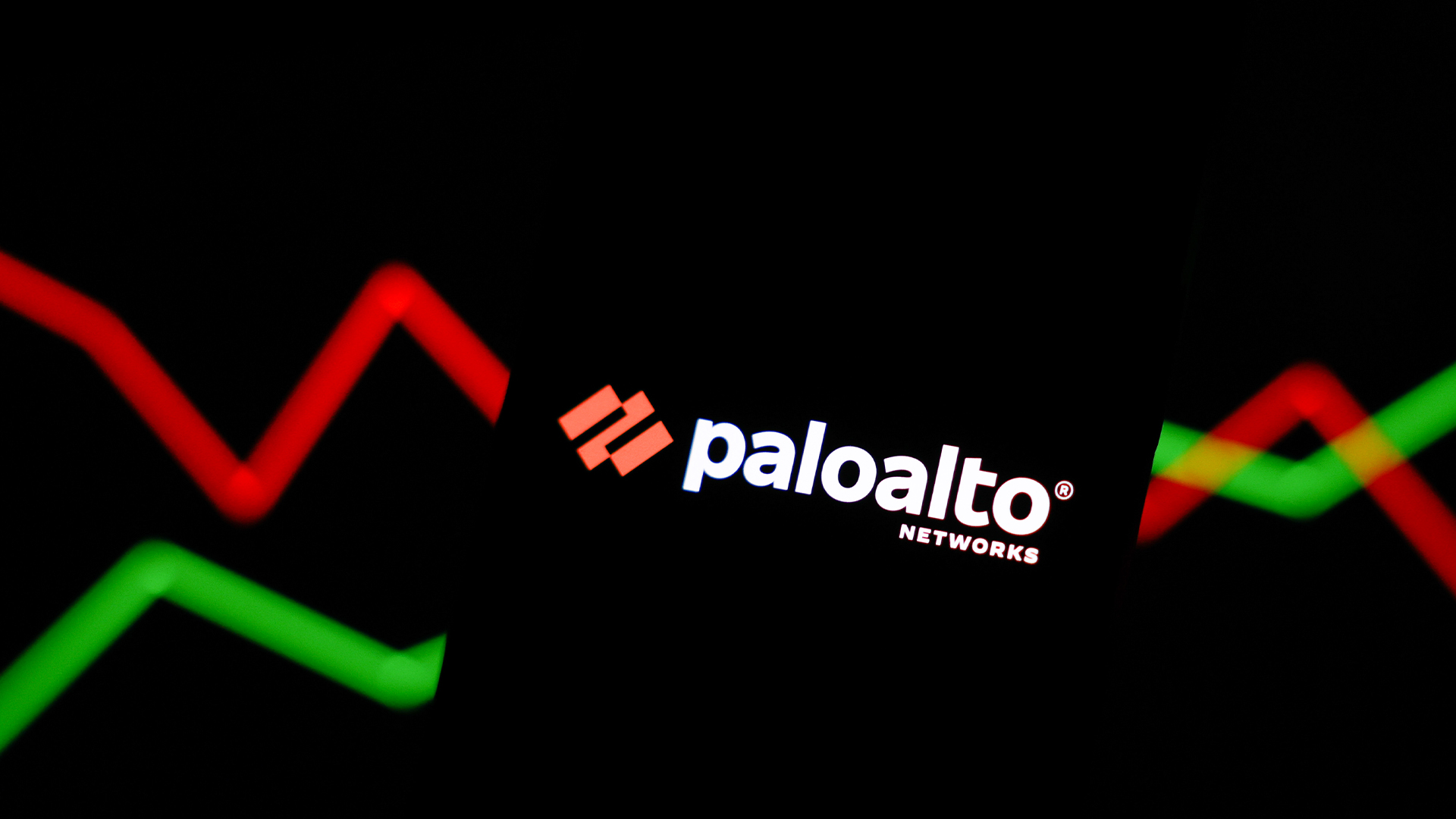 Palo Alto Networks to acquire Chronosphere in $3.35bn deal
Palo Alto Networks to acquire Chronosphere in $3.35bn dealNews The cybersecurity vendor will combine Chronosphere’s observability platform with its own Cortex AgentiX offering
By Daniel Todd Published
-
 Security experts claim the CVE Program isn’t up to scratch anymore — inaccurate scores and lengthy delays mean the system needs updated
Security experts claim the CVE Program isn’t up to scratch anymore — inaccurate scores and lengthy delays mean the system needs updatedNews CVE data is vital in combating emerging threats, yet inaccurate ratings and lengthy wait times are placing enterprises at risk
By Emma Woollacott Published
-
 Gartner says 40% of enterprises will experience ‘shadow AI’ breaches by 2030 — educating staff is the key to avoiding disaster
Gartner says 40% of enterprises will experience ‘shadow AI’ breaches by 2030 — educating staff is the key to avoiding disasterNews Staff need to be educated on the risks of shadow AI to prevent costly breaches
By Emma Woollacott Published
